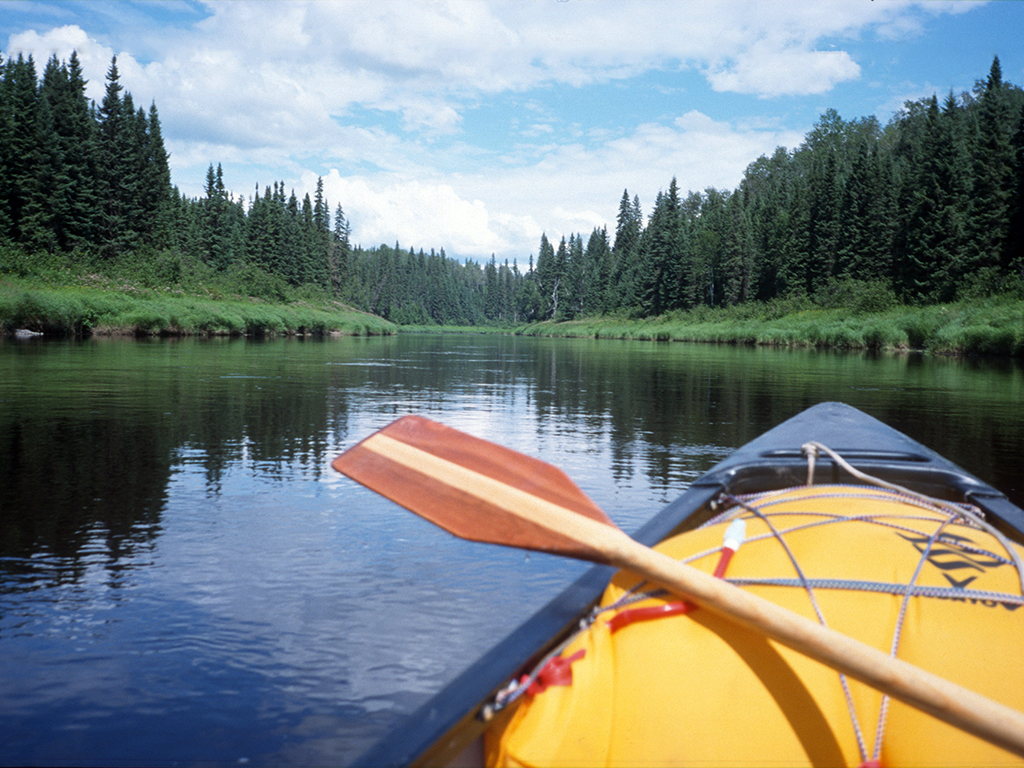The smoke and smell of curried beef simmering on the fire drifted over our campsite near the end of the Chochocouane River. The warm June wind steadily grew stronger as we hauled our canoe to the sparking campfire and flipped it over to use as a wind break.
Sweat streamed down our faces under the scorching sun as we anchored the tent with large rocks. Nearby, the water powering white through the narrow river channel beckoned my partner Marilyn and I to cool off in a shallow pool. We were finally ready to enjoy our last night on the river.
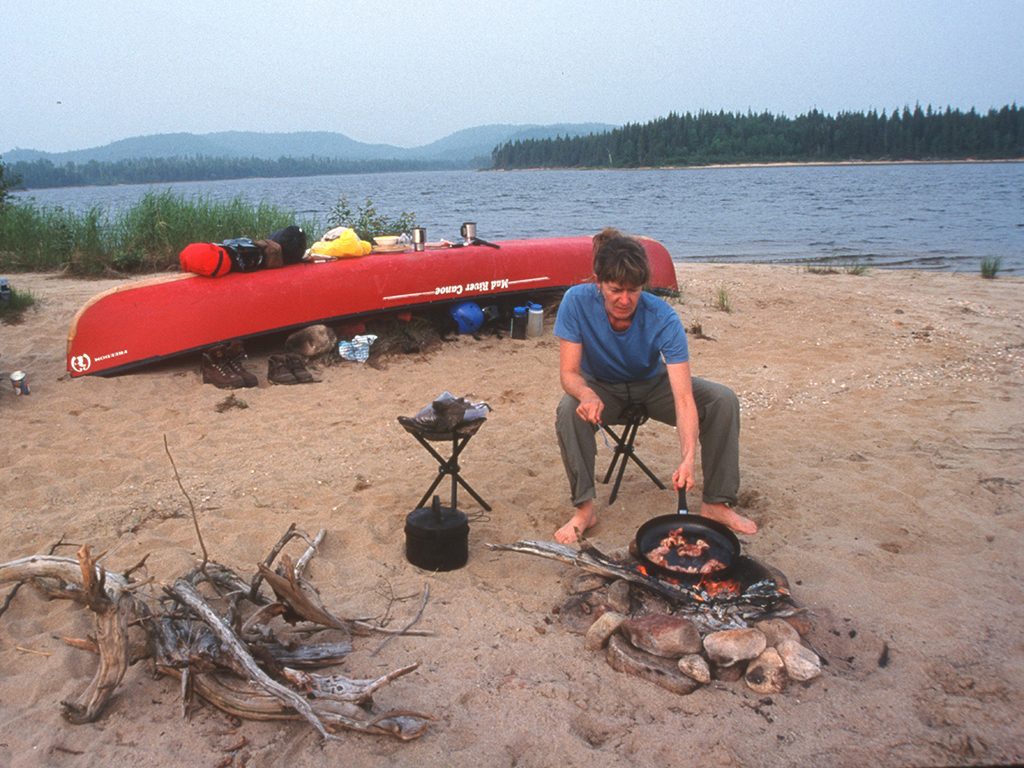 After a final check of our coming meal, we strolled toward the water. Just then, a huge gust of wind rushed in from the south, flattened our tent, and picked the canoe up like a leaf. The boat bounced off the granite and flew through the air before it boofed right side up into the river current and started floating towards the top of the rapids.
After a final check of our coming meal, we strolled toward the water. Just then, a huge gust of wind rushed in from the south, flattened our tent, and picked the canoe up like a leaf. The boat bounced off the granite and flew through the air before it boofed right side up into the river current and started floating towards the top of the rapids.
We spun into action. Marilyn threw a life jacket to me as I grabbed a paddle and dove into the water. Frantically, I swam toward the wayward canoe, heaved myself aboard, and paddled out of an unwelcome run down the rapids.
When I finally got back to shore and still gasping for air, I looked up at Marilyn and didn’t have to say a word. We knew how serious the incident could have been. Had we been tending the fire for another minute, the canoe could have smashed directly into our heads, and probably pummeled us into the hard rock at our feet. It wouldn’t have been a pretty end to the trip.
Some wilderness canoe trips seem to serve up brand new lessons on the power of nature, no matter how straightforward and relaxing the trip is supposed to be. The Chochocouane is one of those rivers that makes canoe tripping seem relatively easy to pull off while offering all of the solitude, wildlife, and diverse geography one can hope for.
A three-hour drive north of Ottawa takes you to the former Algonquin and coureur de bois fur trade route which runs through the northeast section of LaVerendrye Wildlife Reserve, Quebec. Named after the explorer who discovered the Rocky Mountains, the 13,615 square km reserve is twice as large as Algonquin Provincial Park yet attracts far fewer visitors since it is not as close to major population centres.
With two vast man-made reservoirs and 4,000 natural lakes, fishing is the main attraction and anglers cast for northern pike, walleye and lake trout. But the park is also renowned for its 2,000 kms. of flatwater canoe routes and handful of rivers that offer the adventure of running rapids such as the Capitachouane, Gens-de-Terre, and the Chochocouane.
The Chochocouane has more than 10 sets of rapids ranging from small boulder gardens to chutes and are good practice for novice whitewater paddlers since most are fairly short and rescue is very manageable. For those unwilling to try their hand at paddling white water, well-marked portages are there for the taking around every rapid. None of the portages are very long or very steep, and they are well maintained as are the campsites which come complete with toilet boxes and fire pits. Since a half-decent logging road meets the river at various points, paddlers can easily vary the length of the trip and can get off the river quickly if emergencies arise.
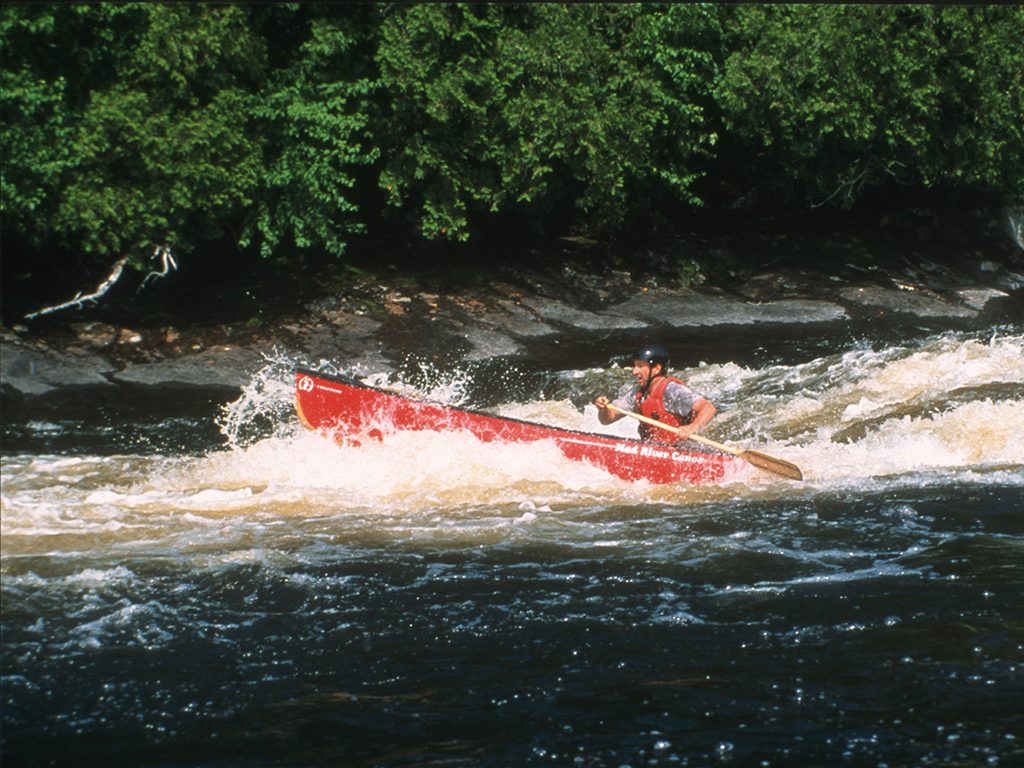
Park staff have mapped four trips on the Chochocouane which vary from 32 to 132 km long. We chose to spend five days paddling a 68-km route from Lac Cambrai to an RV campground on the shore of the Dozois Reservoir just off of Highway 117 and discovered that there is much to see and learn on this river.
Wild roses grow up the steep banks of the Chochocouane as it flows out of Lac Cambrai and cuts through tall stands of black and white spruce, jack pine and birch that grow to the very edge of the water. The growth obscures much of the disturbing sight of clear cut areas along the first 20 km of river which attracts an array of songbirds.
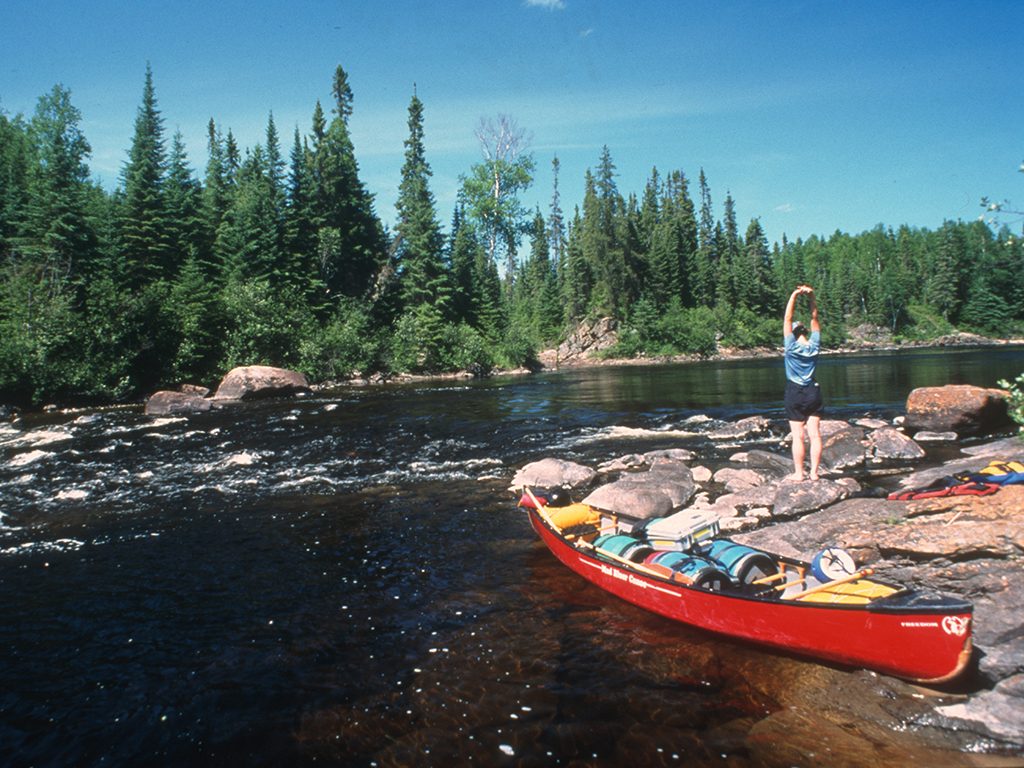 During the first two days, we saw other signs of human presence, too: small bridges, hunting cabins and an old native hunting camp. But soon after, the river flows into true wilderness, save for an ancient native road that runs parallel to it. An abundance of marshes and creeks offer excellent chances to see wildlife.
During the first two days, we saw other signs of human presence, too: small bridges, hunting cabins and an old native hunting camp. But soon after, the river flows into true wilderness, save for an ancient native road that runs parallel to it. An abundance of marshes and creeks offer excellent chances to see wildlife.
More than 150 species of birds make their home in the park as well as 40 species of mammals, including moose, black bears, and wolves. A wolf pack is known to haunt a lower stretch of the route at the confluence of the Canimiti River but we weren’t lucky to see any of these majestic animals.
A real surprise stood further up river, though. On our third day, we were just kicking into total relaxation mode – taking photos close to the shore as we floated down the meandering river. The lazy current pulled us around another bend when a young bear suddenly appeared at the water’s edge almost close enough to touch. It looked straight at us, then, thankfully, turned and bolted back into the forest. We nervously paddled down river to get some distance from our startled neighbour, passing several excellent campsites and a moose carcass floating in the water.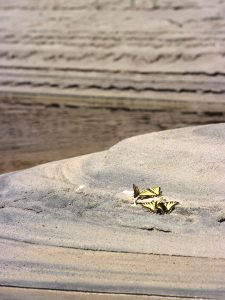
About 10 kilometres downstream from our bear encounter, we stopped to make camp as darkness closed in at a beach site for two complete with a rock table perfect for our meals. As cozy as the site was, the sounds of the forest kept our imaginations peaked and our sleep restless. Little did we know that Mother Nature had even more in store for us the next night.
In the morning, we followed the snaking Chochocouane through the hillsides where a recent forest fire produces an eerie scene of blackened finger-like trees before it slips around giant boulders protruding from the water along a long alley way. Soon after, the river swells at the confluence of a small lake where swallowtail butterflies gathered to sun themselves on sandy bends.
The river soon picks up speed and the rapids become more voluminous. It was here that we decided to camp on a barren island to escape the swarm of mosquitoes that had followed wherever we paddled. Frustrated by the constant onslaught, we hoped the wind on the small open island would help dispel the intruders. The island split the river into a waterfall on one side and on the other, a long and dangerous rapid filled with jagged rocks that were exposed like shark’s teeth.
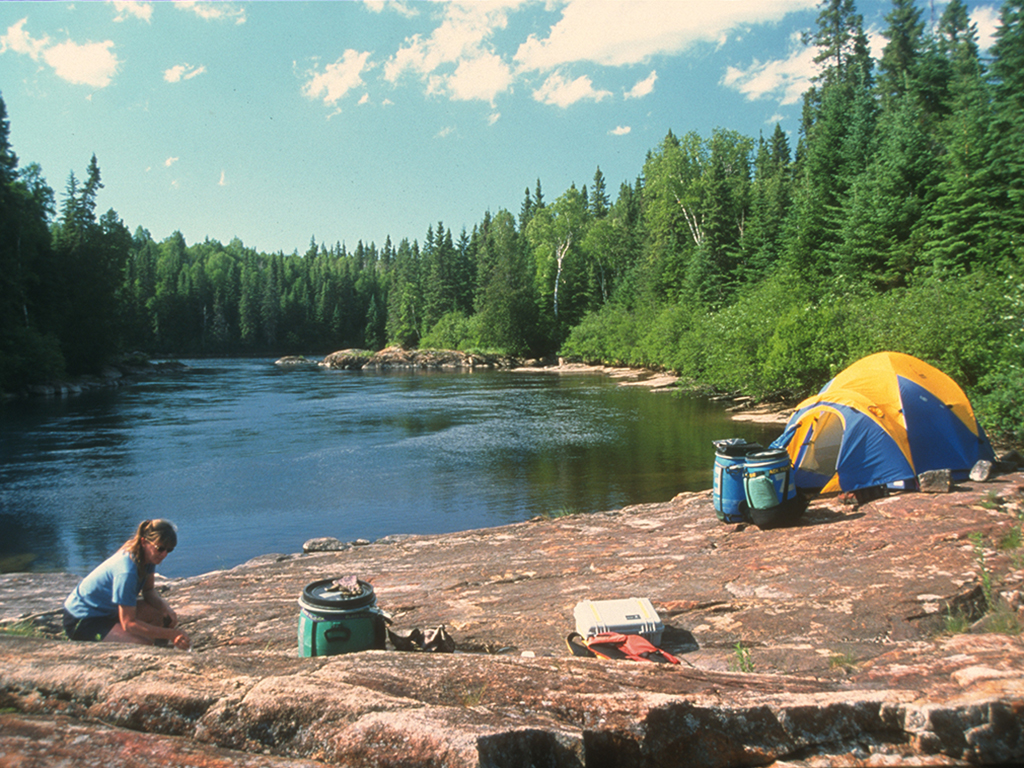
Evening came quickly as storm clouds brewed overhead. Our tent was pitched on a slab of flat rock about two metres from the churning froth, tied down to the canoe and two waterproof canoeing barrels. Then the rain came, pelting the tent for hours as the sky glowed a fiery orange.
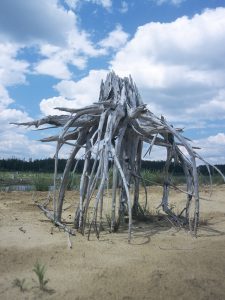
Marilyn woke me at about 2 a.m. and frantically pointed to the rising waterline just outside our tent. We had two choices – pack up in a raging storm and attempt to paddle across the channel above the falls, or stay put and risk the possibility of getting swept down the river by the swelling river. After much discussion, we decided to wait out the storm and constantly checked the water level. Just before dawn, the storm broke, and we nodded off, drenched with stress.
On our last day, we lay back in the canoe somewhere in the middle of the Dozois Reservoir and watched cotton-white clouds float by as dragonflies danced overhead.. Hundreds of sun-dried tree roots sat like giant spiders on the reservoir’s islands and sandy shores around us. With the end in sight, we took stock of our adventure and lessons learned on this short but eventful journey. Mother Nature reminded us to always expect the unexpected and learn from our mistakes or pay the price the next time. I was just glad to get a second chance.
Story by Ralph Plath
Photos by Ralph Plath
and Marilyn Mikkelsen
Getting There and Back:
Access and Exit Points:
Shuttles, equipment, and guides are available just off the highway at Le Domaine, La Verendrye’s main headquarters.
La Vérendrye Canoe-Camping Registration Centre
– website – Canot-camping La Vérendrye
– tel. – 819 435-2331 (May to September)
or 514 252-3001 (from the middle of September to the middle of May)
The authors put-in at Lac Cambrai, 144 kilometres north of Le Domaine. Roads to the lake are primarily gravel. If you want to do the shuttle yourself, a GPS isn’t a bad idea. (The authors found that their driver, a Wildlife Reserve staff member, had some difficulty nailing down the exact put-in even with one.)
It’s also possible to take a train to a put-in much further upriver from Lac Cambrai for considerably more adventure. Talk to La Verendrye staff and the railways in Montreal.
Expect to pay a camping fee for each night in the reserve. You’ll need an access permit to fish.
Suggested Reading
La Verendrye Wildlife Reserve – Canoe Routes
